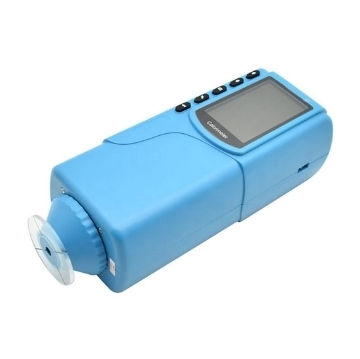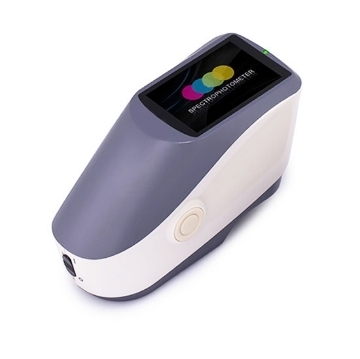Color is a fundamental aspect of our perception and communication, influencing everything from product design to visual art. In various industries, precise color measurement is critical, and this is where colorimeters shine. In this blog, we will delve into the intricate workings of colorimeters, unraveling how these devices function to accurately measure and quantify color.
Understanding Color Measurement:
Color measurement involves quantifying the visual perception of color. Humans perceive color based on the wavelengths of light that objects reflect or emit. Colorimeters are instruments designed to mimic this process, providing objective and consistent color measurements for a wide range of applications.
Key Components of a Colorimeter:
A colorimeter is composed of several essential components that work in harmony to measure color accurately:
- Light Source: Colorimeters emit controlled light onto the target sample. The light source can be either an LED or an incandescent lamp, emitting light across the visible spectrum.
- Filters: Filters are used to isolate specific wavelengths of light. Colorimeters often employ red, green, and blue filters to mimic the human eye's response to these primary colors.
- Photodetector: The photodetector measures the intensity of light reflected from or transmitted through the sample. It converts this light energy into electrical signals that can be processed and analyzed.
- Optics and Measuring Aperture: Optics direct the light from the source onto the sample and then to the photodetector. The measuring aperture is the opening through which the colorimeter captures light from the sample. The aperture's size determines the area of the sample being measured.
- Calibration Mechanism: To ensure accurate measurements, colorimeters undergo calibration, aligning their readings with established color standards.
Step-by-Step Process of Color Measurement:
- Illumination: The color measurement process begins with the illumination of the sample. The colorimeter emits controlled light onto the surface of the object or material being measured. The light source within the colorimeter is often an LED (light-emitting diode) or an incandescent lamp that emits light across the visible spectrum.
- Filters: As the emitted light interacts with the sample, it contains various wavelengths corresponding to different colors. Colorimeters use filters to isolate specific wavelengths or color components of the light. The most common filters used are red, green, and blue (RGB), which correspond to the primary colors that the human eye perceives.
- Sample Interaction: The sample reflects or transmits light, and its color is determined by the wavelengths it absorbs and the ones it reflects or transmits. The filtered light interacts with the sample's surface, and the sample's color characteristics affect how it interacts with different wavelengths of light.
- Photodetector Reading: After interacting with the sample, the reflected or transmitted light is directed towards a photodetector. The photodetector is a sensitive device that converts light energy into electrical signals. The photodetector measures the intensity of the filtered light for each color component (red, green, and blue) separately.
- Data Processing: The electrical signals generated by the photodetector are then sent to the colorimeter's internal electronics for processing. Complex algorithms and mathematical models are used to calculate color values based on the ratios of the intensities of the filtered light components.

- Color Representation: The colorimeter generates color values that correspond to established color spaces, such as the CIE XYZ or CIE Lab* color space. These color spaces define specific attributes of color, including hue, brightness, and saturation. These color values provide a standardized way to quantify and describe the color of the sample.
- Display and Analysis: The color values are then displayed on the colorimeter's screen or sent to a connected device, such as a computer or a printer. Users can analyze and interpret the color values to make informed decisions based on the color characteristics of the sample.
- Calibration and Maintenance: Regular calibration is essential to maintain the accuracy and reliability of the colorimeter's measurements. Calibration ensures that the colorimeter's readings align with established color standards. Over time, colorimeters can experience drift or changes in performance due to factors like aging or environmental conditions. Regular calibration corrects these deviations and maintains measurement accuracy.
Applications and Benefits:
Colorimeters find applications in various industries:
- Graphic Design and Printing: Colorimeters ensure consistent color reproduction across various media, including prints and displays.
- Food and Beverage Industry: Color measurement helps assess the quality and appearance of food products and beverages.
- Textiles and Fashion: Accurate color measurement ensures consistent dyeing and color matching in the textile industry.
- Automotive Coatings: Colorimeters ensure color consistency in paint and coatings, maintaining brand standards.
- Medical Diagnostics: In medical applications, colorimeters aid in analyzing biological samples and detecting subtle color changes.
Colorimeters are sophisticated devices that replicate human color perception to provide objective and reliable color measurements. By understanding how they work, we gain insight into their role in maintaining color consistency, quality control, and artistic expression across diverse industries. Sisco offers high-quality colorimeters. Colorimeters are invaluable tools that bridge the gap between our perception of color and its precise measurement, shaping the way we interact with the colorful world around us.

